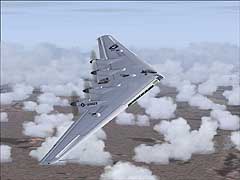
Farmboyzim's Flight Sim's
Aircraft of the World
Northrop Flying Wing
By Farmboyzim

Click Picture For Larger View
It began back in 1929, when John Northrop designed and developed a two seat, single engine aircraft in the form of a basic "wing", with two slim booms supporting the tail unit. This aircraft was powered by a 90 horsepower Menasco engine, which initially drove a pusher propeller. A decade passed, until Northrop could further pursue his all-wing concept, when in 1940, the Northrop N-1M flew with two 65 hp engines, also driving pusher propellers. The N-1M was truly an all-wing designed aircraft, which had low drag and greater acceleration in both dive and glide. This design enable the aircraft to use less power on take off versus its conventional cousins of similar size and weight. Very few problems were encountered with this aircraft. The main problem that was resolved with engine and prop modifications was engine cooling.
Having gained invaluable experience with the development of the N-1M, Northrop was convinced that an all-wing bomber was definitely a feasible concept. Following an evaluation by USAAF engineers a design contract was awarded to Northrop under the designation XB-35. Four scaled down versions of the bomber were developed to provide flight data, however the first was lost in a fatal crash.
In November of 1941, the USAAF ordered two prototype XB-35 flying wing bombers, powered by four 3,000 hp Pratt & Whitney R-4360 Wasp Major piston engines driing eight-bladed counter rotating pusher propellers. Thirteen more aircraft, designated YB-35 were ordered in early 1943. Many problems were encountered with the counter rotating propellers and the gearboxes, but finally, the first maiden flight was flown by the XB-35 on June 25, 1946, followed by a second flight the following year.
With the end of WW II, and orders being placed for the competing Convair B-36 the fate of the piston engine B-35 was sealed, but Northrop, having forseen this possibility, received approval from the USAF to modify two of the YB-35's to jet power with the redesignation of YB-49. The first of these aircraft flew on October 21, 1947, powered by eight 4,000 lb thrust Allison J35 engines. The second of these aircraft was powered by six 5,600 lb thrust Allison engines, four buried in the wings, and two in underslung pods.
Air force officers gave very complimentary reports on the YB-49, and the service was convinced of the advantages of an all-wing aircraft, but in June of 1948, the second YB-49 was destroyed with the loss of its five man crew, which was attributed to structural failure. But in spite of this tragedy, the service still ordered 30 of the modified RB-49A aircraft, one of which was to be built by Northrop, and 29 built by Consolidated Vultee because of prior contractual agreements, but the order was later cancelled to provide funds for the
B-36.
October of 1949 saw the end of the Flying Wing program, and the aircraft were scrapped, The sole survivor was the six jet YB-49A, but four years later, this was also scrapped. There were some variations on the wing theme, among them , the XP-56, the first all magnesium, all welded airframe, intended to be an advanced fighter. There was also the XP-79 Flying Ram aircraft, which was designed to ram enemy aircraft, cutting them up in mid-air. The airframe was intended to survive 10 such "interceptions". I would imagine that pilots were not especially disappointed when this idea did not "take off"!
Although the Flying Wing lives on only in history, we see that the concept of the flying wing design lives on in modern aircraft, such as the Stealth aircraft.
Click On Pictures For Larger View


Thanks For The Visit !



